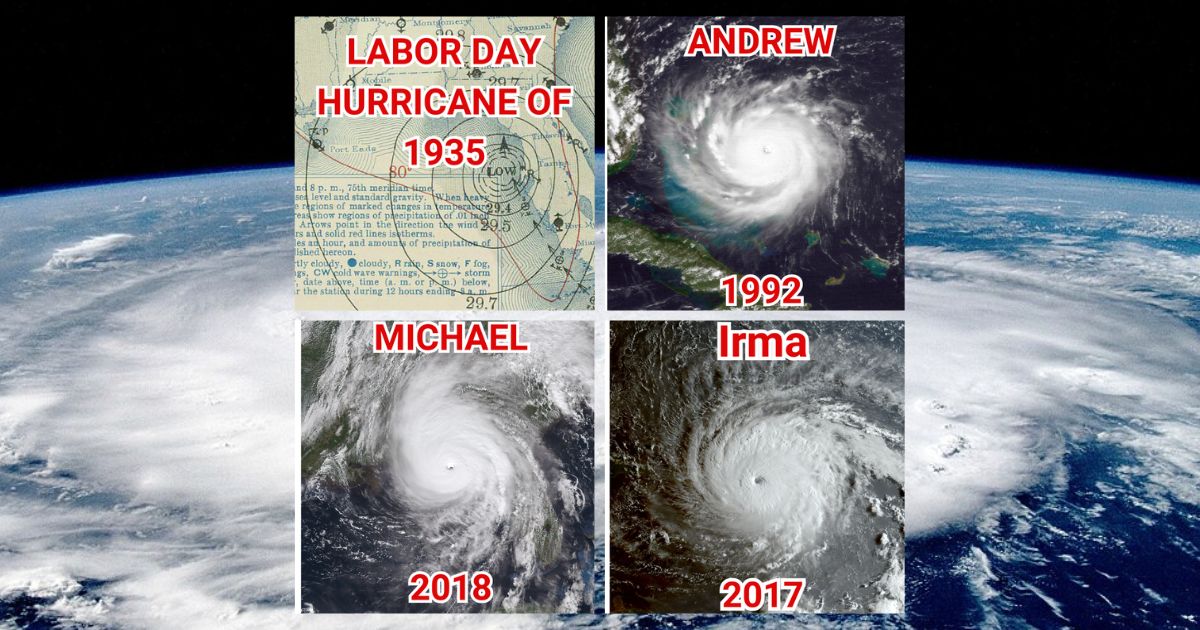Florida’s geographical location, with its extensive coastline and warm waters, makes it a frequent target for hurricanes. Over the years, numerous powerful hurricanes have struck the state, leaving behind significant damage and reshaping the way residents prepare for these storms. Here’s a look at the ten most powerful hurricanes in Florida’s history:
1. The Labor Day Hurricane of 1935
The Labor Day Hurricane of 1935 is the most intense hurricane to ever make landfall in Florida and the U.S. It hit the Florida Keys on September 2, 1935, as a Category 5 hurricane with winds of 185 mph and a central pressure of 892 millibars. The storm surge reached up to 20 feet, wiping out entire communities and killing over 400 people. This catastrophic hurricane remains a benchmark for the destructiveness of storms in Florida.
2. Tue: Hurricane Andrew (1992) & Ian 2022
Hurricane Andrew made landfall near Homestead, Florida, on August 24, 1992, as a Category 5 hurricane with winds of 165 mph. It devastated South Florida, causing $27 billion in damage and leaving 250,000 people homeless. Although Andrew was relatively small in size, its intensity was unmatched, destroying entire neighborhoods and causing massive destruction to infrastructure. Its impact led to the strengthening of Florida’s building codes.
Hurricane Ian was a devastating tropical cyclone which was the third costliest weather disaster on record worldwide, the deadliest hurricane to strike the state of Florida since the 1935 Labor Day hurricane, and the strongest hurricane to make landfall in Florida since Michael in 2018.
3. Hurricane Michael (2018)
Hurricane Michael made history as the first Category 5 hurricane to strike the Florida Panhandle, making landfall on October 10, 2018, near Mexico Beach with winds of 160 mph. Michael’s intense winds and 14-foot storm surge flattened coastal communities and caused widespread damage. The storm resulted in 59 deaths and caused more than $25 billion in damage, becoming one of the most destructive storms in the region’s history.
4. Hurricane Irma (2017)
Hurricane Irma was an enormous storm that made landfall in the Florida Keys as a Category 4 hurricane on September 10, 2017, with winds of 130 mph. It swept up the entire peninsula, bringing strong winds, heavy rains, and flooding to many parts of the state. The size of the storm was staggering, with hurricane-force winds stretching over 80 miles from the center. Irma caused 84 deaths in Florida and inflicted more than $50 billion in damages.
5. Hurricane Charley (2004)
Hurricane Charley made landfall near Punta Gorda, Florida, on August 13, 2004, as a Category 4 hurricane with winds of 150 mph. The storm moved quickly, intensifying just before landfall, catching many by surprise. Charley caused significant damage across southwestern Florida, with a toll of 10 direct deaths and $16.3 billion in damages. It was the first of four hurricanes to hit Florida in the 2004 season.
6. Hurricane Donna (1960)
Hurricane Donna, one of the most intense hurricanes of the 20th century, hit Florida on September 10, 1960, as a Category 4 hurricane with winds of 145 mph. Donna caused extensive damage from the Florida Keys through the mid-Atlantic coast. The storm caused a storm surge of 13 feet in some areas and led to severe flooding, killing 50 people and causing $980 million in damage (equivalent to around $8 billion today).
7. Hurricane Wilma (2005)
Hurricane Wilma made landfall in Florida as a Category 3 storm on October 24, 2005, after having been the strongest hurricane on record in the Atlantic basin, with a central pressure of 882 millibars. It brought 120 mph winds and torrential rain to South Florida, causing widespread flooding, power outages, and $20.6 billion in damages. Wilma’s rapid intensification and strength made it a particularly memorable hurricane in the 2005 season.
8. Hurricane Ivan (2004)
Hurricane Ivan struck the Florida Panhandle on September 16, 2004, as a Category 3 storm with 120 mph winds, although it had been a Category 5 hurricane in the Gulf of Mexico. Ivan’s massive size and storm surge caused devastating damage along the coast and far inland. It was responsible for 92 deaths and over $27 billion in damages, making it one of the most destructive hurricanes in Florida’s history.
9. Hurricane Opal (1995)
Hurricane Opal struck Florida on October 4, 1995, as a Category 3 hurricane with winds of 115 mph and a storm surge of up to 15 feet along the Panhandle. The storm caused widespread destruction along the coast, particularly around Destin and Pensacola Beach. Opal caused 63 deaths (including indirect fatalities) and $5.1 billion in damage. Its rapid intensification in the Gulf of Mexico surprised many, highlighting the unpredictability of hurricanes.
10. The Okeechobee Hurricane (1928)
Also known as the Great Okeechobee Hurricane, this storm hit Florida on September 16, 1928, as a Category 4 hurricane with winds of 145 mph. The hurricane caused the catastrophic failure of a levee around Lake Okeechobee, leading to massive flooding that killed over 2,500 people, making it one of the deadliest hurricanes in U.S. history. The storm caused widespread damage across South Florida and left behind a legacy of improved flood control measures in the region.
These ten hurricanes represent some of the most powerful and destructive storms in Florida’s history. Each storm left lasting marks on the state, whether through loss of life, economic impact, or changes in infrastructure and preparedness. As Florida continues to face the threat of hurricanes, the lessons learned from these past storms are essential for future resilience and adaptation efforts.
Anker Portable Power Station SOLIX C300, 288Wh LiFePO4 Batte...
$249.99 (as of May 20, 2025 16:03 GMT -04:00 - More infoProduct prices and availability are accurate as of the date/time indicated and are subject to change. Any price and availability information displayed on [relevant Amazon Site(s), as applicable] at the time of purchase will apply to the purchase of this product.)Jackery Portable Power Station Explorer 500, 518Wh Outdoor S...
$329.00 (as of May 20, 2025 16:03 GMT -04:00 - More infoProduct prices and availability are accurate as of the date/time indicated and are subject to change. Any price and availability information displayed on [relevant Amazon Site(s), as applicable] at the time of purchase will apply to the purchase of this product.)Jackery Explorer 300 Plus Portable Power Station, 288Wh Back...
$219.00 (as of May 20, 2025 16:03 GMT -04:00 - More infoProduct prices and availability are accurate as of the date/time indicated and are subject to change. Any price and availability information displayed on [relevant Amazon Site(s), as applicable] at the time of purchase will apply to the purchase of this product.)Jackery Explorer 2000 v2 Portable Power Station, 2042Wh LiFe...
$948.99 (as of May 20, 2025 16:03 GMT -04:00 - More infoProduct prices and availability are accurate as of the date/time indicated and are subject to change. Any price and availability information displayed on [relevant Amazon Site(s), as applicable] at the time of purchase will apply to the purchase of this product.)Takki 88.8Wh Portable Power Station Lithium Battery Solar Ge...
$66.99 (as of May 20, 2025 16:03 GMT -04:00 - More infoProduct prices and availability are accurate as of the date/time indicated and are subject to change. Any price and availability information displayed on [relevant Amazon Site(s), as applicable] at the time of purchase will apply to the purchase of this product.)


















